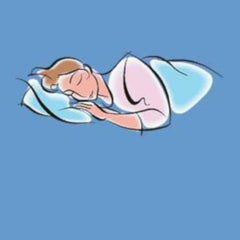What Happens When We Sleep?
 Sleep was long considered just a uniform block of time when you are not awake. Thanks to sleep studies done over the past several decades, it is now known that sleep has distinct stages that cycle throughout the night in predictable patterns. How well rested you are and how well you function depend not just on your total sleep time but on how much of the various stages of sleep you get each night. Your brain stays active throughout sleep, and each stage of sleep is linked to a distinctive pattern of electrical activity known as brain waves.
Sleep was long considered just a uniform block of time when you are not awake. Thanks to sleep studies done over the past several decades, it is now known that sleep has distinct stages that cycle throughout the night in predictable patterns. How well rested you are and how well you function depend not just on your total sleep time but on how much of the various stages of sleep you get each night. Your brain stays active throughout sleep, and each stage of sleep is linked to a distinctive pattern of electrical activity known as brain waves.Sleep is divided into two basic types: rapid eye movement (REM) sleep and non-REM sleep (with four different stages). (See “Types of Sleep” on page 5.) Typically, sleep begins with non-REM sleep. In stage 1 non-REM sleep, you sleep lightly and can be awakened easily by noises or other disturbances. During this first stage of sleep, your eyes move slowly, and your muscle activity slows. You then enter stage 2 non-REM sleep, when your eye movements stop. Your brain shows a distinctive pattern of slower brain waves with occasional bursts of rapid waves. When you progress into stage 3 non-REM sleep, your brain waves become even slower, although they are still punctuated by smaller, faster waves. By stage 4 non-REM sleep, the brain produces extremely slow waves almost exclusively. Stages 3 and 4 are considered deep sleep, during which it is very difficult to be awakened. Children who wet the bed or sleep walk tend to do so during stages 3 or 4 of non-REM sleep. Deep sleep is considered the “restorative” part of sleep that is necessary for feeling well rested and energetic during the day.
During REM sleep, your eyes move rapidly in various directions, even though your eyelids remain closed. Your breathing also becomes more rapid, irregular, and shallow, and your heart rate and blood pressure increase. Dreaming typically occurs during REM sleep. During this type of sleep, your arm and leg muscles are temporarily paralyzed so that you cannot “act out” any dreams that you may be having. The first period of REM sleep you experience usually occurs about an hour to an hour and a half after falling asleep. After that, the sleep stages repeat themselves continuously while you sleep. As the night progresses, REM sleep time becomes longer, while time spent in non-REM sleep stages 3 and 4 becomes shorter. By morning, nearly all your sleep time is spent in stages 1 and 2 of non-REM sleep and in REM sleep. If REM sleep is disrupted during one night, REM sleep time is typically longer than normal in subsequent nights until you catch up.
Overall, almost one-half your total sleep time is spent in stages 1 and 2 non-REM sleep and about one-fifth each in deep sleep (stages 3 and 4 of non-REM sleep) and REM sleep. In contrast, infants spend half or more of their total sleep time in REM sleep. Gradually, as they mature, the percentage of total sleep time they spend in REM progressively decreases to reach the one-fifth level typical of later childhood and adulthood. Why people dream and why REM sleep is so important are not well understood. It is known that REM sleep stimulates the brain regions used in learning and the laying down of memories.
Animal studies suggest that dreams may reflect the brain’s sorting and selectively storing important new information acquired during wake time. While this information is processed, the brain might revisit scenes from the day while pulling up older memories. This process may explain why childhood memories can be interspersed with more recent events during dreams. Studies show, however, that other stages of sleep besides REM are also needed to form the pathways in the brain that enable us to learn and remember.
Summary of Types of Sleep Rem Sleep: Usually first occurs about 90 minutes after you fall asleep; cycles along with the non-REM stages throughout the night. Eyes move rapidly, with eyelids closed. Breathing is more rapid, irregular, and shallow. Heart rate and blood pressure increase. Dreaming occurs.Arm and leg muscles are temporarily paralyzed.
Non-REM Sleep REM Sleep Stage 1: Light sleep; easily awakened; muscle activity; eye movements slow down.
Stage 2: Eye movements stop; slower brain waves, with occasional bursts of rapid brain waves.
Stage 3: Considered deep sleep; difficult to awaken; brain waves slow down more, but still have occasional rapid waves.
Stage 4: Considered deep sleep; difficult to awaken; extremely slow brain waves.

